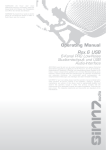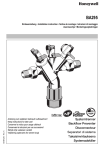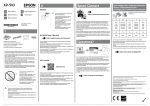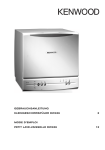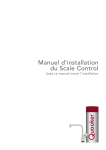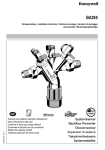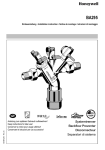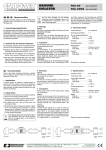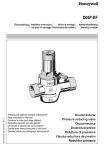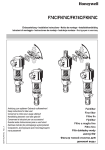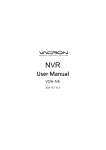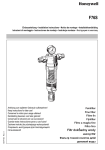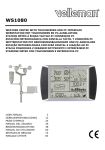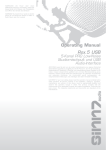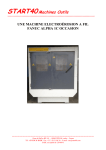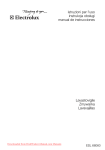Download Heizungswasser-Behandlungseinheit Heater water
Transcript
VE300 Einbauanleitung Installation instructions Istruzioni di montaggio Instrukcja montażu EBA-VE300 Rev.A Anleitung zum späteren Gebrauch aufbewahren! Keep instructions for later use! Conserver la notice pour usage ultérieur! Conservare le istruzioni per uso successivo! Zachowa instrukcj do pózniejszego wykorzystania! Návod uschovejte pro pozdější použití! Notice de montage Návod na montáž Heizungswasser-Behandlungseinheit Heater water treatment unit L'appareil de traitement de l'eau de chauffage L'unitŕ di trattamento dell'acqua di riscaldamento Zespół do zmiękczania wody grzewczej Jednotka na úpravu topné vody D 1. 5. Sicherheitshinweise 1. Beachten Sie die Einbauanleitung. 2. Benutzen Sie das Gerät • bestimmungsgemäß • in einwandfreiem Zustand • sicherheits- und gefahrenbewusst. 3. Beachten Sie, dass das Gerät ausschließlich für den in dieser Einbauanleitung genannten Verwendungsbereich bestimmt ist. Eine andere oder darüber hinausgehende Benutzung gilt als nicht bestimmungsgemäß. 4. Beachten Sie, dass alle Montage-, Inbetriebnahme, Wartungs- und Justagearbeiten nur durch autorisierte Fachkräfte ausgeführt werden dürfen. 5. Lassen Sie Störungen, welche die Sicherheit beeinträchtigen können, sofort beseitigen. 2. 6. 7. Wasser max. 6,0 bar • Installation im Zulauf der Heizungsanlage, Heizungswasser-Behandlungseinheit (VE300) an der Wand befestigen • Einbau in waagrechte Rohrleitung • Der Einbau darf nicht in Räumen oder Schächten erfolgen, in denen giftige Gase oder Dämpfe auftreten und die überflutet werden können (Hochwasser) • Der Einbauort muss frostsicher und gut belüftet sein • Der Einbauort muss gut zugänglich sein - Vereinfacht Wartung und Reinigung • Gemäß DIN EN 1717 in Durchflussrichtung zunächst Nachfüllkombination (NK300), dann unmittelbar danach Heizungswasser-Behandlungseinheit (VE300) installieren • Bei der Montage sind die nationalen Installationsvorschriften zu beachten. • Bei einer Installation ohne Nachfüllkombination (NK300) vor der Heizungswasser-Behandlungseinheit (VE300) eine Absperreinrichtung vorsehen Geeignet für Heizungsanlagen mit folgenden Werkstoffen: Stahl, Kupfer, Kupferlegierungen und Kunststoffe (bei Enthärtung) und Aluminium, Aluminiumlegierungen, Stahl, Kupfer, Kupferlegierungen und Kunststoffe (bei Vollentsalzung). 7.2. Montageanleitung Aufbereitetes Wasser hat veränderte korrosionschemische Parameter. Eine Konditionierung mittels Inhibitoren ist separat vorzusehen. 4. 1. 2. Technische Daten Einbaulage waagrecht Betriebstemperatur max. 30 °C kvs-Wert 0,45 m3/h Anschlussgröße 1/2" Außengewinde Honeywell GmbH Montage 7.1. Einbauhinweise Verwendung Vordruck Standardausführung mit Gewindeanschluss R1/2" Beim Einbau sind die Einbauanleitung, geltende Vorschriften sowie die allgemeinen Richtlinien zu beachten. Funktionsbeschreibung Medium Varianten VE300-1/2A = Die unmittelbar nach der Nachfüllkombination (NK300) installierte Heizungswasser-Behandlungseinheit (VE300) arbeitet bei Enthärtung nach dem Ionentauscherprinzip und ersetzt die im Wasser befindlichen Erdalkalien wie Calcium und Magnesium durch Natriumionen. Abhängig von der regionalen Wasserhärte wird über die Einstellung der Heizungswasser-Behandlungseinheit das Wasser wahlweise teilenthärtet (<8°dH) oder vollenthärtet (<0,11°dH). Bei Vollentsalzung werden alle Salze aus dem Wasser herausgenommen! Bei Vollentsalzung muss die Verschneidung auf 0 gestellt werden! 3. Lieferumfang Die Heizungswasser-Behandlungseinheit (VE300) besteht aus: • Verschneideeinrichtung, bestehend aus Wasserzähler, ausgangsseitiger Absperrmöglichkeit und Entnahmeventil • Edelstahl-Haltebügel mit Befestigungsset • Verschraubungen mit Aussengewinde • Gesamthärtemessbesteck zur Bestimmung der Wasserhärte 3. 4. 2 Bei der Montage gelten die nationalen Installationsvorschriften. Absperrvorrichtung vorsehen um Patronentausch sicher zu stellen. Rohrleitung gut durchspülen Heizungswasser-Behandlungseinheit (VE300) einbauen und mittels der Wandhalterung befestigen • Einbau in waagrechte Rohrleitung • Durchflussrichtung beachten (Pfeilrichtung) • spannungs- und biegemomentfrei einbauen Einbauhöhe min. 55cm vom Boden aus vorsehen, um Patronentausch sicher zu gewährleisten Patrone (siehe Zubehör) in Heizungswasser-Behandlungseinheit (VE300) schrauben und handfest anziehen MU1H-1547GE23 R0712 D 8. Inbetriebnahme 9.1.1. Austausch Enthärter-oder VollentsalzungsPatrone Wenn das Füllvolumen der Heizungsanlage die angegebene Kapazität übersteigt, muss ein Patronenwechsel vorgenommen werden. Ermittlung der maximalen Kapazität der Patrone siehe EBA-P300L beziehungsweise EBA-P300LES Bei Enthärtung: Die maximale Kapazität wird anhand der Gesamtwasserhärte und der Verschneideeinstellung ermittelt. Die Kapazität wird auf der mitgelieferten Tabelle notiert, ebenso wie die jeweils nachgefüllten Wassermengen. Wenn das Füllvolumen den notierten Wasserzählerendstand übersteigt, muss ein Patronenwechsel vorgenommen werden. Ein Wechsel der Enthärterpatrone wird aus Gründen der technischen Sicherheit spätestens 12 Monaten nach der ersten Verwendung empfohlen. Bei Vollentsalzung: Die maximale Kapazität wird anhand der Leitfähigkeit und der Verschneideeinstellung ermittelt. Die Kapazität wird auf der mitgelieferten Tabelle notiert, ebenso wie die jeweils nachgefüllten Wassermengen. Wenn das Füllvolumen den notierten Wasserzählerendstand übersteigt, muss ein Patronenwechsel vorgenommen werden. Ein Wechsel der Vollentsalzugnspatrone wird aus Gründen der technischen Sicherheit spätestens 12 Monate nach der ersten Verwendung empfohlen. 1. Absperrkugelhähne ein- und ausgangsseitig an der Enthärtungseinheit schließen 2. Ausgangsseite durch Öffnen des Probenahmeventils (Entlüftungsventil an Heizungswasser-Behandlungseinheit druckentlasten 3. Patrone aus Heizungswasser-Behandlungseinheit herausdrehen 4. Neue Patrone handfest eindrehen 5. Absperrkugelhähne ein- und ausgangsseitig öffnen 8.1. Enthärtung einstellen 1. Messung der Wasserhärte Mit Hilfe des mitgelieferten Gesamthärtemessbestecks sollte vor der Installation die Wasserhärte gemessen werden. Beachten Sie die Hinweise in der Anleitung des Gesamthärtemessbestecks 2. Heizungswasser-Behandlungseinheit (VE300) mit blauem Verstellgriff einstellen • Die geeignete Verschneideeinstellung (Markierung 0-3 auf Gehäuse der Enthärtungseinheit, ggf. Dämmschale entfernen ) ist abhängig von der regionalen Wasserhärte und der gewünschten Resthärte. Der Wert kann der auf der Patrone angebrachten Tabelle entnommen werden. 8.2. Vollentsalzung einstellen 1. Messung der Leitfähigkeit • Mit Hilfe eines Leitfähigkeitsmessgerät sollte vor der Installation die Leitfähigkeit gemessen werden. 2. Heizungswasser-Behandlungseinheit (VE300) mit blauem Verstellgriff einstellen • Bei Vollentsalzung muss die Verschneidung auf 0 gestellt werden! 8.3. Anlage füllen 1. Absperrkugelhähne ein- und ausgangsseitig an der Enthärtungseinheit langsam öffnen 2. Nach Befüllen der Anlage Absperrkugelhähne schließen 3. Notieren Sie die auf dem Aufkleber der Enthärter-oder Vollentsalzungs-Patrone erforderlichen Parameter 9. Instandhaltung Wartungs-, Instandhaltungs- und Reparaturarbeiten dürfen nur von autorisiertem Fachkräfte durchgeführt werden. 9.1. Wartung Wir empfehlen einen Wartungsvertrag mit einem Installationsunternehmen abzuschließen Entsprechend DIN EN 1717 muss eine regelmäßige Wartung durchgeführt werden. Intervall: 1-3 Jahre (abhängig von den örtlichen Bedingungen) Durchführung durch ein Installationsunternehmen. 10. Entsorgung • Gehäuse aus entzinkungsbeständigem Messing • Mechanische Komponenten der HeizungswasserBehandlungseinheit aus hochwertigem Kunststoff • Dichtungen aus EPDM Die örtlichen Vorschriften zur ordnungsgemäßen Abfallverwertung bzw. Beseitigung beachten! 11. Störungen / Fehlersuche Störung Ursache Behebung Kein oder zu wenig Durchfluss Absperrkugelhähne vor oder nach Nachfüllkombination nicht ganz geöffnet Absperrkugelhähne ganz öffnen MU1H-1547GE23 R0712 3 Honeywell GmbH D 12. Serviceteile 13. Zubehör 2 2192900 VST06-B D06F AD300 P300-S/L / P300-LES D V 1 G N Nr. Bezeichnung Nennweite Artikelnummer 1 Wasserzähler WZ300 2 Entlüftungsventil 2421100 NK300 BA295 2192900 Absperrkugelhahn Anschlussgröße 1/2" VST06-B Anschluss-Set Mit Löttülle P300-S Enthärter-Patrone 0,75l Enthärter-Patrone mit Ionentauscher-Harz P300-L Enthärter-Patrone 3,5l Enthärter-Patrone mit Ionentauscher-Harz P300-LES Vollentsalzungs-Patrone 3,5l Vollentsalzungs-Patrone mit AustauscherHarz AD300 Adapter Zum Anschluss der Enthärtungseinheit an 3/4" Aussengewinde D06F Druckminderer Schallschutz-Druckminderer mit Einstellskala Vordruck max. 16 bar mit Klarsichtsiebtasse, 25 bar mit Messingsiebtasse, Hinterdruck 1,5 - 6 bar A = Klarsichtsiebtasse bis 40°C / 16 bar B = Messingsiebtasse bis 70°C / 25 bar BA295 NK300 Honeywell GmbH 4 Systemtrenner Zur Absicherung von Trinkwasseranlagen gegen Rückdrücken, Rückfließen und Rücksaugen. Abgesichert werden Flüssigkeiten bis einschließlich Flüssigkeitskategorie 4 nach DIN EN 1717. Nachfüllkombination Flüssigkeitskategorie 4, mit Manometer, Absperrkugelhahn und Isolierschale MU1H-1547GE23 R0712 GB 1. 5. Safety Guidelines 1. Follow the installation instructions. 2. Use the appliance • according to its intended use • in good condition • with due regard to safety and risk of danger. 3. Note that the appliance is exclusively for use in the applications detailed in these installation instructions. Any other use will not be considered to comply with requirements and would invalidate the warranty. 4. Please take note that any assembly, commissioning, servicing and adjustment work may only be carried out by authorized persons. 5. Immediately rectify any malfunctions which may influence safety. 2. 6. 7. Inlet pressure max. 6,0 bar • Installation in the inlet to the heating system, fasten the heater water treatment unit (VE300) to the wall • Installation into horizontal pipeline • The installation may not take place in areas or ducts where poisonous gases or vapours may be present or where flooding can occur • The installation environment should be protected against frost and ventilated well • The installation location has to be easily accessible - Simplified maintenance and cleaning • Acc. to DIN EN 1717 in direction of flow, first install the refilling combination (NK300) and directly after it, the heater water treatment unit (VE300) • The national installation regulations must be observed during the assembly. • When installing a refilling combination (NK300) above the heater water treatment unit (VE300), provide a shut-off device Suitable for heating systems with the following materials: Steel, copper, copper alloys and plastics (for softening) and aluminium, aluminium alloys, steel, copper, copper alloys and plastic (for complete demineralisation). 7.2. Assembly instructions Treated water has modified corrosive chemical parameters. Conditioning by means of inhibitors is to be provided for separately. 4. 1. 2. Technical data Installation position horizontal Operating temperature max. 30 °C kvs-value 0.45 m3/h Connection size 1/2" External thread 3. 4. Honeywell GmbH Assembly 7.1. Installations Guidelines Application Water Standard version with threaded connection R1/2" It is necessary during installation to follow the installation instructions, to comply with local requirements and to follow the codes of good practice. Description of function Medium Options VE300-1/2A = The heater water treatment unit (VE300) installed directly below the refilling combination (NK300) uses the ionic exchange principle to soften water, replacing alkaline earths such as calcium and magnesium with sodium ions. Depending on the regional water hardness, the heater water treatment unit is set to partially soften (<8°dH) or completely soften (<0.11°dH) the water. Complete demineralisation will completely remove the mineral deposits in the water! For complete demineralisation, the dilution must be set to 0! 3. Scope of delivery The heater water treatment unit (VE300) consists of: • Blending unit, consisting of water flow meter, outlet-sided blocking capability and bleeder valve • Stainless steel mounting bracket with connection set • Threaded male connections • Total hardness test-kit to determine water hardness 5 The national installation regulations apply during the assembly. Provide shut-off device to safeguard cartridge exchange Thoroughly flush pipework Install heater water treatment unit (VE300) and secure in place with the wall bracket • Install in horizontal pipeline • Note flow direction (indicated by arrow) • Install without tension or bending stresses Set installation height min. 55cm from the ground to ensure reliable cartridge exchange. Screw the cartridge (see accessories) into the heater water treatment unit (VE300) and tighten by hand MU1H-1547GE23 R0712 GB 8. Start-up 9.1.1. Changing the softening or complete demineralisation cartridge When the filling level of the heating system exceeds the specified capacity, a cartridge exchange has to be performed. To determine the maximum capacity of the cartridge, refer to EBA-P300L or EBA-P300LES For softening: The maximum capacity is determined according to the total water hardness and the dilution setting. The capacity is noted on a table included in the scope of delivery, as well as the respectively added amounts of water. If the filling level exceeds the noted water flow meter end value, a cartridge exchange has to be performed. An exchange of the softening cartridge is recommended at least 12 months after its first usage due to technical safety purposes. For complete demineralisation The maximum capacity is determined according to the conductivity and the dilution setting. The capacity is noted on a table included in the scope of delivery, as well as the respectively added amounts of water. If the filling level exceeds the noted water flow meter end value, a cartridge exchange has to be performed. An exchange of the demineralisation cartridge is recommended at least 12 months after its first usage due to technical safety purposes. 1. Close the ball valve on the inlet and outlet side of the blending unit 2. Decompress the outlet side by opening the sampling valve (air bleed valve of the heater water treatment unit) 3. Unscrew the cartridge from the heater water treatment unit 4. Screw the new cartridge in manually 5. Open ball valves on the inlet and outlet side 8.1. Adjust softening 1. Measuring the water hardness with support from the total hardness test-kit, included in the scope of delivery, the water hardness should be measured before the installation. Observe the information in the instruction manual of the total hardness test-kit 2. Adjust heater water treatment unit (VE300) with blue adjuster knob • The suitable dilution setting (marker 0-3 on the casing of the dilution unit, remove insulation lining if necessary) is dependant on the regional water hardness and the desired residual hardness. The value can be extracted from the table attached to the cartridge. 8.2. Set to complete demineralisation 1. Measure the conductivity • Before installation, an electrical conductivity meter should be used to measure the conductivity. 2. Adjust heater water treatment unit (VE300) with blue adjuster knob • For complete demineralisation, the dilution must be set to 0! 8.3. Filling up the system 1. Slowly open the ball valve on the inlet and outlet side of the blending unit 2. After filling up the system, close the ball valves 3. Note the required parameters listed on the label of the softening or complete demineralisation cartridge 9. Maintenance Maintenance, service and repair work may be carried out only by authorised technicians. 9.1. Maintenance We recommend a planned maintenance contract with an installation company In accordance with DIN EN 1717 a regular maintenance must be taken. Frequency: every 1-3 years (depending on local operating conditions) To be carried out by an installation company 10. Disposal • Dezincification-resistant brass housing • Mechanical components of the heater water treatment unit made of high-quality plastic • EPDM sealing washers Observe the local requirements regarding correct waste recycling/disposal! 11. Troubleshooting Problem Cause No or too small water flow rate Ball valves up- or downstream of refilling combi- Open ball valves entirely nation are not fully open MU1H-1547GE23 R0712 Remedy 6 Honeywell GmbH GB 12. Spare Parts 13. Accessories 2 2192900 VST06-B D06F AD300 P300-S/L / P300-LES D V 1 G N No. Description Dimension Part No. 1 Water flow meter WZ300 2 Air bleed valve 2421100 BA295 NK300 2192900 Shutoff valve Connection size 1/2" VST06-B Connection set Solder connections P300-S Softening cartridge 0.75l softening cartridge with ionic exchange resin P300-L Softening cartridge 3.5l softening cartridge with ionic exchange resin P300-LES Complete demineralisation cartridge 3.5l complete demineralisation cartridge with exchange resin AD300 Adapter To fit the softening unit to a 3/4“ male connection. D06F Pressure reducing valve Noise protected pressure reducing valve with setting scale. Maximum inlet pressure 16 bar, with brass filter bowl 25 bar, outlet pressure range 1.5 6.0 bar A = With clear filter bowl up to 40 °C / 16 bar B = With brass filter bowl up to 70 °C / 25 bar BA295 Backflow Preventer To protect drinking water systems against back pressure, backflow and withdrawal. Protection against fluids up to and including fluid category 4 acc. to DIN EN 1717. NK300 Refilling combination Liquid catagory 4, with pressure gauge, shutoff valve and isolating shell Honeywell GmbH 7 MU1H-1547GE23 R0712 F 1. Consignes de sécurité 5. 1. Suivre les indications de la notice de montage. 2. En ce qui concerne l'utilisation de l'appareil • Utiliser cet appareil conformément aux données du constructeur • Maintenir l'appareil en parfait état • Respectez les consignes de sécurité 3. Il faut noter que cet équipement ne peut être mis en oeuvre que pour les conditions d'utilisation mentionnées dans cette notice. Toute autre utilisation, ou le non respect des conditions normales d'utilisation, serait considérée comme non conforme. 4. Observer que tous les travaux de montage, de mise en service, d'entretien et de réglage ne pourront être effectués que par des spécialistes agréés. 5. Prendre des mesures immédiates en cas d'anomalies mettant en cause la sécurité. 2. 6. 7. 7.1. Dispositions à prendre • Montage sur la conduite d'amenée de l'installation de chauffage, fixer l'appareil de traitement de l'eau de chauffage (VE300) au mur • Montage sur une conduite horizontale • Le montage ne doit pas être effectué dans des locaux ou des conduits dans lesquels des gaz ou des vapeurs toxiques apparaissent et qui peuvent être ventilés (montée de l'eau) • Le lieu de montage doit être protégé contre le gel et bien aéré • Le lieu de montage doit être accessible facilement - Pour simplifier l'entretien et le nettoyage • Installer la combinaison de remplissage (NK300) en amont dans le sens de circulation de l'eau, puis directement en aval l'appareil de traitement de l'eau de chauffage (VE300) conformément à DIN EN 1717 • Lors du montage, les consignes d'installation nationales en vigueur doivent être respectées. • Lors du montage sans combinaison de remplissage (NK300), prévoir un dispositif d'arrêt avant l'appareil de traitement de l'eau de chauffage (VE300) Mise en oeuvre Eau 6,0 bar max. Destiné aux installations de chauffage contenant les éléments suivants : acier, cuivre, alliages cuivreux et matières plastique (pour l'adoucissement) et aluminium, alliages d'aluminium, acier, cuivre, alliages cuivreux et matières plastique (pour le dessalement complet). 7.2. Instructions de montage Les consignes d'installation nationales en vigueur prévalent lors du montage. Prévoir un dispositif d'arrêt afin de permettre le remplacement des cartouches. 1. Bien rincer la conduite 2. Monter l'appareil de traitement de l'eau de chauffage (VE300) et l'immobiliser au moyen de la fixation murale • Montage sur une conduite horizontale • Contrôlez la direction de l'écoulement (direction de la flèche) • Vérifier l'absence de contraintes anormales en traction et en flexion L'eau traitée possède des paramètres de corrosion chimiques différents. Un conditionnement au moyen d'inhibiteurs de corrosion doit être prévu séparément. 4. Caractéristiques Montage Température de fonctionnement Valeur du kvs Dimensions de raccordement Honeywell GmbH Montage Pour le montage, respecter la notice d’installation, les consignes en vigueur et les directives générales. Description fonctionelle Fluide Pression amont Variantes VE300-1/2 A = Modèle standard avec raccord fileté R1/2" L'appareil de traitement de l'eau de chauffage (VE300) installé directement en aval de la combinaison de remplissage (NK300) fonctionne selon le principe d'échange d'ions lors de l'adoucissement, et remplace les alcalinoterreux qui se trouvent dans l'eau, comme le calcium et le magnésium, par des ions sodium. Le réglage de l'appareil de traitement de l'eau de chauffage permet de sélectionner un adoucissement partiel de l'eau (<8°dH) ou un adoucissement complet (<0,11°dH) selon la dureté de l'eau de la région. Lors du dessalement complet, l'eau est débarrassée de tous ses sels. Lors du dessalement complet, le mitigeur doit être réglé sur 0. 3. Contenu de la livraison L'appareil de traitement de l'eau de chauffage (VE300) comprend : • un mitigeur constitué d'un compteur de l'eau, d'une possibilité d'arrêt du côté sortie et d'une valve de purge • un étrier de blocage en acier inoxydable avec un kit de fixation • des raccords vissés à filetage extérieur • un dispositif de mesure de la dureté totale pour déterminer la dureté de l'eau horizontal 30 °C max. 0,45 m3/h 1/2'' filetage extérieur 8 MU1H-1547GE23 R0712 F 9.1.1. Remplacement des cartouches d'adoucissement ou de dessalement complet Si le volume de remplissage de l'installation de chauffage dépasse la capacité affichée, la cartouche doit être remplacée. Pour déterminer la capacité maximale de la cartouche, voir EBA-P300L et EBA-P300LES Lors de l'adoucissement : La capacité maximale est déterminée en fonction de la dureté de l'eau totale et du réglage du mitigeur. La capacité est inscrite dans un tableau compris dans la livraison, en fonction de la quantité d'eau remplie. Si le volume de remplissage dépasse la valeur finale indiquée par le compteur d'eau, la cartouche doit être remplacée. La cartouche d'adoucissement doit être remplacée au plus tard 12 mois après la première utilisation pour des raisons de sécurité technique. Lors du dessalement complet : La capacité maximale est déterminée en fonction de la conductivité et du réglage du mitigeur. La capacité est inscrite dans un tableau compris dans la livraison, en fonction de la quantité d'eau remplie. Si le volume de remplissage dépasse la valeur finale indiquée par le compteur d'eau, la cartouche doit être remplacée. La cartouche de dessalement complet doit être remplacée au plus tard 12 mois après la première utilisation pour des raisons de sécurité technique. 1. Fermer lentement les robinets d'arrêt à boisseau sphérique des côtés entrée et sortie situés sur l'adoucisseur 2. Réduire la pression du côté sortie en ouvrant la vanne de prise d'échantillon (vanne d'échappement de l'appareil de traitement de l'eau de chauffage) 3. Dévisser la cartouche de l'appareil de traitement de l'eau de chauffage 4. Visser une nouvelle cartouche à la main 5. Ouvrir les robinets d'arrêt à boisseau sphérique des côtés entrée et sortie 3. Prévoir une hauteur de montage à 55cm min. du sol afin de permettre le remplacement des cartouches 4. Visser les cartouches (voir accessoires) dans l'appareil de traitement de l'eau de chauffage (VE300) et les serrer à la main 8. Mise en service 8.1. Réglage de l'adoucissement 1. Mesure de la dureté de l'eau La dureté de l'eau doit être mesurée avant le montage au moyen du dispositif de mesure de la dureté totale compris dans la livraison. Respecter les consignes de la notice du dispositif de mesure de la dureté totale 2. Régler l'appareil de traitement de l'eau de chauffage (VE300) au moyen de la poignée de réglage bleue • Le réglage correct du mitigeur (marques 0-3 sur le boîtier de l'adoucisseur, retirer l'enveloppe isolante si nécessaire) dépend de la dureté de l'eau de la région et de la dureté souhaitée. Se reporter aux tableaux dont dispose la cartouche pour connaître la valeur. 8.2. Réglage du dessalement complet 1. Mesure de la conductivité • La conductivité doit être mesurée avant le montage au moyen d'un appareil de mesure de la conductivité. 2. Régler l'appareil de traitement de l'eau de chauffage (VE300) au moyen de la poignée de réglage bleue • Lors du dessalement complet, le mitigeur doit être réglé sur 0. 8.3. Remplissage de l'installation 1. Ouvrir lentement les robinets d'arrêt à boisseau sphérique des côtés entrée et sortie situés sur l'adoucissseur 2. Fermer les robinets d'arrêt à boisseau sphérique une fois l'installation remplie 3. Noter sur l'autocollant de la cartouche d'adoucissement ou de dessalement complet les paramètres obligatoires 9. Maintenance Les travaux d'entretien, de maintenance et de réparation ne doivent être effectué que par un personnel professionnel autorisé. 10. Matériel en fin de vie 9.1. Maintenance • Corps en laiton résistant à la dézincification • Éléments mécaniques de l'appareil de traitement de l'eau de chauffage en matières plastique de haute qualité • Joints en EPDM Se conformer à la réglementation pour l'élimination des équipements industriels en fin de vie vers les filières de traitement autorisées! Nous recommandons de souscrire à un contrat d'entretien avec un installateur On devra réaliser une maintenance régulière conformément à la norme DIN EN 1717. Périodicité:De 1 à 3 ans en fonction des conditions d'utilisation Opération effectuée par un professionnel 11. Défaut / recherche de panne Panne Peu ou trop peu d'écoulement MU1H-1547GE23 R0712 Cause Remède Robinet de fermeture pas complètement ouvert Ouvrir complètement le robinet de fermeavant ou après la combinaison de remplissage ture 9 Honeywell GmbH F 12. Apercu pièces 13. Accessoires 2 2192900 VST06-B D06F AD300 P300-S/L / P300-LES 1 D V G N N° Désignation 1 2 Compteur d'eau Vanne d'échappement Honeywell GmbH Diamètre nominal Numéro d'article WZ300 2421100 BA295 NK300 2192900 Robinet d'arrêt à boisseau sphérique Taille du raccord 1/2" VST06-B Set de raccord Avec douille à souder P300-S Cartouche d'adoucissement Cartouche d'adoucissement de 0,75l avec résine échangeuse d'ions P300-L Cartouche d'adoucissement Cartouche d'adoucissement de 3,5l avec résine échangeuse d'ions P300-LES Cartouche de dessalement complet Cartouche de dessalement complet de 3,5l avec résine échangeuse d'ions AD300 Adaptateur Destiné au raccord de l'adoucisseur à un filetage extérieur de 3/4'' D06F Régulateur de pression Régulateur de pression antibruit avec échelle de réglage. Pression d’alimentation maxi. 16 bar avec pot de décantation transparent, 25 bar avec pot de décantation en laiton, A = pot de décantation transparent jusqu’à 40°C / 16 bar B = pot de décantation en laiton jusqu’à 70°C / 25 bar BA295 Séparateur de système Pour sécuriser les installations d'eau portable contre la contre-pression, le contre-écoulement et la contre-aspiration. Les liquides y compris la catégorie 4 selon DIN En 1717 sont sécurisés. NK300 Combinaison de remplissage Catégorie de fluide 4, avec manomètre, robinet d'arrêt à boisseau sphérique et coque isolante 10 MU1H-1547GE23 R0712 I 1. Avvertenze di sicurezza 5. Fornitura 1. Rispettare le istruzioni di montaggio. 2. Utilizzare l'apparecchio - secondo la destinazione d'uso - solo se integro - in modo sicuro e consapevoli dei pericoli connessi 3. Si prega di considerare che l'apparecchio è realizzato esclusivamente per il settore d'impiego riportato nelle presenti istruzioni d'uso. Un uso differente o diverso da quello previsto è da considerarsi improprio. 4. Osservare che tutti i lavori di montaggio, di messa in funzione, di manutenzione e di regolazione devono essere eseguiti soltanto da tecnici specializzati e autorizzati. 5. I guasti che potrebbero compromettere la sicurezza devono essere risolti immediatamente. L'unità di trattamento dell'acqua di riscaldamento (VE300) è costituita da: • miscelatore, costituito da contatore acqua, innesto per dispositivo di chiusura in uscita e valvola di prelievo • Staffa in acciaio inox con kit di fissaggio • Collegamenti a vite con filettatura esterna • kit di misura della durezza totale per la determinazione della durezza dell'acqua 2. • Installazione nella tubazione di mandata dell'impianto di riscaldamento. Fissare l'unità di trattamento dell'acqua di riscaldamento (VE300) alla parete • Installazione su tubazione orizzontale • È vietata l'installazione in locali o pozzetti in cui si possano generare gas o vapori nocivi e soggetti a allagamento (acqua di piena) • Il luogo di installazione deve essere protetto dal gelo e deve essere ben ventilato • Il luogo di installazione deve essere di facile accesso - Rende più semplice la manutenzione e la pulizia • Secondo DIN EN 1717, installare nella direzione del flusso prima il gruppo di riempimento (NK300) e subito a valle l'unità di trattamento dell'acqua di riscaldamento (VE300) • Durante il montaggio devono essere rispettate le norme di installazione nazionali. • In caso di installazione senza gruppo di riempimento (NK300), prevedere un dispositivo di bloccaggio a monte dell'unità di trattamento dell'acqua di riscaldamento (VE300) 6. 7. 7.1. Istruzioni di installazione Descrizione del funzionamento Uso Mezzo acqua Pressione a monte max. 6,0 bar Adatto per impianti di riscaldamento con i seguenti materiali: acciaio, rame, leghe di rame e materiali sintetici (addolcimento) e alluminio, leghe di alluminio, acciaio, rame, leghe di rame e materiali sintetici (demineralizzazione totale). 7.2. Istruzioni di montaggio L’acqua trattata ha parametri chimici corrosivi modificati. Un condizionamento con inibitori deve essere previsto separatamente. 4. 1. 2. Dati tecnici Posizione di installazione orizzontale Temperatura di esercizio max. 30 °C kvsValore 0,45 m3/h Dimensioni attacchi 1/2" filettatura esterna Honeywell GmbH Versione standard con attacco filettato R1/2" Montaggio Al montaggio è necessario osservare il manuale di montaggio, le norme vigenti nonché le direttive generali. L'unità di trattamento dell'acqua di riscaldamento (VE300) installata immediatamente a valle del gruppo di riempimento (NK300) realizza l'addolcimento in base al principio dello scambio ionico, sostituendo gli elementi alcalino-terrosi come calcio e magnesio presenti nell'acqua con ioni di sodio. In funzione della durezza dell'acqua locale, l'acqua può essere addolcita parzialmente (<8°dH) o completamente (<0,11°dH) impostando in modo corrispondente l'unità di trattamento. Con la demineralizzazione totale, dall'acqua vengono eliminati tutti i sali! Per la demineralizzazione totale il miscelatore deve essere impostato su 0. 3. Varianti VE300-1/2A = 3. 4. 11 Durante il montaggio rispettare le norme di installazione nazionali. Prevedere un dispositivo di bloccaggio per garantire la sostituzione delle cartucce. Sciacquare bene la tubazione. Installare l'unità di trattamento dell'acqua di riscaldamento (VE300) e fissarla con il supporto a parete • Installazione su tubazione orizzontale • Osservare la direzione di flusso (direzione della freccia) • senza tensione e momento flettente Prevedere un'altezza di installazione di almeno 55 cm dal pavimento per garantire una sostituzione sicura delle cartucce Avvitare la cartuccia (vedere accessori) nell'unità di trattamento dell'acqua di riscaldamento (VE300) e serrarla a mano MU1H-1547GE23 R0712 I 8. Messa in servizio 8.1. Regolazione dell'addolcimento 1. Misurazione della durezza dell'acqua Prima dell'installazione eseguire una misurazione con il kit di misura della durezza totale in dotazione. Osservare le avvertenze nelle istruzioni del kit di misura della durezza totale 2. Impostare l'unità di trattamento dell'acqua di riscaldamento (VE300) con la manopola di regolazione blu • La corretta regolazione del miscelatore (tacca 0-3 sul corpo del miscelatore, se necessario rimuovere il guscio isolante) dipende dalla durezza dell'acqua locale e dalla durezza residua desiderata. Il valore si trova nella tabella riportata sulla cartuccia. 8.2. Regolazione della demineralizzazione totale 1. Misurazione della conducibilità • Prima dell'installazione, misurare la conducibilità con l'ausilio di un apposito dispositivo di misurazione. 2. Impostare l'unità di trattamento dell'acqua di riscaldamento (VE300) con la manopola di regolazione blu • Per la demineralizzazione totale il miscelatore deve essere impostato su 0. 8.3. Riempimento dell'impianto 1. Aprire lentamente i rubinetti di chiusura in ingresso e in uscita sull'unità di addolcimento 2. Terminato il riempimento dell'impianto chiudere i rubinetti di chiusura 3. Prendere nota dei parametri richiesti sull'etichetta della cartuccia di addolcimento o di demineralizzazione totale 9. Manutenzione La manutenzione ordinaria e straordinaria e le riparazioni devono essere eseguite esclusivamente da personale qualificato e autorizzato. 9.1. Manutenzione Consigliamo di stipulare un contratto di manutenzione con un'azienda di installazione In conformità alla norma DIN EN 1717 bisogna eseguire una manutenzione periodica. Frequenza: ogni 1-3 anni (in base alle condizioni presenti) Esecuzione ad opera di un'azienda di installazione 11. Guasti / Ricerca guasti Guasto Flusso assente o troppo basso MU1H-1547GE23 R0712 9.1.1. Sostituzione di una cartuccia di addolcimento o di demineralizzazione totale 1. Se il volume di riempimento dell'impianto di riscaldamento supera la capacità indicata sostituire la cartuccia. Per la determinazione della capacità massima della cartuccia, vedere le istruzioni per P300L o per P300LES Per addolcimento: La capacità massima viene determinata in base alla durezza totale dell'acqua e all'impostazione del miscelatore. La capacità è riportata nelle tabelle in dotazione assieme alle rispettive quantità di acqua riempita. Se il volume di riempimento supera il livello finale riportato per il contatore dell'acqua, sostituire la cartuccia. Per ragioni di sicurezza tecnica si raccomanda di sostituire la cartuccia di addolcimento al più tardi 12 mesi dopo il primo utilizzo. Per demineralizzazione totale: La capacità massima viene determinata in base alla conducibilità e all'impostazione del miscelatore. La capacità è riportata nelle tabelle in dotazione assieme alle rispettive quantità di acqua riempita. Se il volume di riempimento supera il livello finale riportato per il contatore dell'acqua, sostituire la cartuccia. Per ragioni di sicurezza tecnica si raccomanda di sostituire la cartuccia di demineralizzazione totale al più tardi 12 mesi dopo il primo utilizzo. 1. Chiudere i rubinetti di chiusura in ingresso e in uscita sull'unità di addolcimento 2. Scaricare la pressione sul lato di uscita aprendo la valvola di prelievo (valvola di sfiato dell'unità di trattamento dell'acqua di riscaldamento) 3. Svitare e rimuovere la cartuccia dall'unità di trattamento dell'acqua di riscaldamento 4. Serrare a mano la nuova cartuccia 5. Aprire i rubinetti di chiusura in ingresso e in uscita 10. Smaltimento • Corpo in ottone resistente alla dezincatura • Componenti meccanici dell'unità di trattamento dell'acqua di riscaldamento in materiale sintetico di alta qualità • Guarnizioni in EPDM Rispettare le norme locali relative al riciclaggio o allo smaltimento a regola d'arte di rifiuti! Causa Risoluzione Rubinetti di chiusura a monte e a valle del gruppo Aprire completamente i rubinetti di riempimento non aperti completamente 12 Honeywell GmbH I 12. Pezzi di ricambio 13. Accessori 2 2192900 VST06-B D06F AD300 P300-S/L / P300-LES 1 D V G N N. Denominazione 1 2 contatore dell'acqua valvola di sfiato Larghezza- N. art. nominale WZ300 2421100 BA295 NK300 2192900 Rubinetto di chiusura Dimensione dell'attacco 1/2" VST06-B Kit di allacciamento Con becco saldato P300-S Cartuccia di addolcimento Cartuccia di addolcimento da 0,75 litri con resina per scambio ionico P300-L Cartuccia di addolcimento Cartuccia di addolcimento da 3,5 litri con resina per scambio ionico P300-LES Cartuccia di demineralizzazione totale Cartuccia di demineralizzazione totale da 3,5 litri con resina per scambio AD300 Adattatore Per il collegamento dell'unità di addolcimento alla filettatura esterna da 3/4" D06F BA295 NK300 Honeywell GmbH 13 Riduttore di pressione Riduttore di pressione ad isolamento acustico con scala di regolazione. Pressione a monte max. 16 bar con tazza di filtro trasparente, 25 bar con tazza di filtro di ottone, pressione a valle 1,5 - 6 bar A = tazza di filtro trasparente fino a 40°C / 16 bar B = tazza di filtro di ottone fino a 70°C / 25 bar Separatore di sistema Per la sicurezza degli impianti di acqua potabile contro inversione di pressione, riflusso e sifonaggio. La sicurezza è garantita per i liquidi fino alla categoria di liquidi 4 compresa (secondo DIN EN 1717). Gruppo di riempimento Categoria di liquidi 4, con manometro, rubinetto di chiusura e guscio di isolamento MU1H-1547GE23 R0712 PL 1. 5. Wskazówki bezpieczeDstwa Zakres dostawy 1. Przestrzegać instrukcji montażu. 2. Proszę użytkować urządzenie • zgodnie z jego przeznaczeniem • w nienagannym stanie • ze świadomością bezpieczeństwa i zagrożeń 3. Proszę uwzględnić, że urządzenie przeznaczony jest wyłącznie dla zakresu zastosowania określonego w niniejszej instrukcji montażu. Każde inne lub wykraczające poza to użytkowanie uznawane jest jako niezgodne z przeznaczeniem. 4. Proszę uwzględnić, że wszystkie prace montażowe mogą być wykonywane tylko przez autoryzowany personel fachowy. 5. Wszystkie usterki, które mogą naruszyć bezpiec zeństwo należy natychmiast usunąć. Zespół do zmiękczania wody grzewczej (VE300) składa się z następujących komponentów: • urządzenie mieszające, składające się z wodomierza, możliwości odcięcia po stronie wyjściowej i zaworu czerpalnego • jarzma mocującego ze stali nierdzewnej z zestawem montażowym • dwuzłączek z gwintem zewnętrznym • zestaw pomiarowy twardości ogólnej do określania twardości wody 2. Podczas montażu przestrzegaę instrukcji montażu, obowiązujacych przepisów oraz ogólnych zasad 6. VE300-1/2A = 7. Opis funkcji Zespół do zmiękczania wody grzewczej, zainstalowany bezpośrednio za zespołem napełniającym, pracuje na zasadzie wymiany jonów i zamienia zawarte w wodzie jony metali alkalicznych (wapnia i magnezu) na jony sodu. W zależności od twardości wody w regionie i ustawienia zespołu zmiękczającego, woda może zostaę zmiękczona częściowo (<8űdH) lub całkowicie (<0,11űdH). W przypadku całkowitego odsalania wody usunięte z niej zostają wszystkie sole! Przy odsalaniu całkowitym rowek musi byę ustawiony w pozycji 0! 3. 7.2. Instrukcja montażu Dane techniczne poziomo max. 30 °C 0,45 m3/h 1/2" gwint zewnętrzny 1. 2. 3. 4. Honeywell GmbH Montaż • Montaż w dopływie instalacji grzewczej, zespół do zmiękczania wody (VE300) mocowany jest do ściany • Montaż w poziomym przewodzie rurowym • Nie wolno montowaę w pomieszczeniach lub szybach, w których występują trujące gazy lub pary i które mogłyby ulec zalaniu (powódź) • Miejsce montażu musi byę wolne od mrozu i dobrze przewietrzane • Miejsce montażu musi byę łatwo dostępne - UŠatwia konserwacjÍ i czyszczenie • Zgodnie z DIN EN 1717 w kierunku przepływu należy zainstalowaę najpierw zespół napełniający (NK300), a zaraz po nim zespół do zmiękczania wody (VE300) • Przy montażu należy przestrzegaę lokalnych krajowych przepisów montażowych. • Jeśli nie jest montowany zespół napełniający (NK300), to przed zespołem do zmiękczania wody (VE300) należy zainstalowaę zawór odcinający Zastosowanie Pozycja montażowa Temperatura robocza Wartośę kvs Rozmiar przyłącza Wersja standardowa z podłączeniem na gwint R1/2" 7.1. Montaż Czynnik Woda Ciśnienie wejściowe maks. 6,0 bar Do instalacji grzewczych zawierających następujące materiały: stal, miedź, stopy miedzi i tworzywa sztuczne (w przypadku zmiękczania) oraz aluminium, stopy aluminium, stal, miedź, stopy miedzi i tworzywa sztuczne (w przypadku całkowitego odsalania wody). Uzdatniona woda ma zmienione parametry korozyjne. Należy oddzielnie przewidzieę zabezpieczenie za pomocą inhibitorów korozji. 4. Warianty 14 Przy montażu należy przestrzegaę lokalnych krajowych przepisów montażowych. Należy przewidzieę zawór odcinający, aby umożliwię wymianę wkładów. Dokładnie przepłukaę przewód przyłączeniowy Zamontowaę zespół do zmiękczania wody (VE300) i przymocowaę przy użyciu uchwytu ściennego • Montaż w poziomym przewodzie rurowym • Przepływ w kierunku wskazanym przez strzałkę • w stanie wolnym od naprężeń i momentów zginających Wysokośę montażu powinna wynosię min. 55 cm od posadzki, aby umożliwię wymianę wkładu Przykręcię i mocno dociągnąę wkład (patrz akcesoria) w zespole do zmiękczania wody (VE300) MU1H-1547GE23 R0609 PL 8. Uruchomienie 9.1.1. Wymiana wkładu do zmiękczania lub odsalania wody Wkład należy wymienię w przypadku, gdy zostanie przekroczona podana pojemnośę instalacji grzewczej. Maksymalna pojemnośę wkładu Đ patrz EBA-P300L lub EBA-P300LES W przypadku zmiękczania: Maksymalna pojemnośę określana jest na podstawie całkowitej twardości wody i ustawienia rowka. Objętośę jest notowana na dołączonej tabeli, tak jak i właśnie uzupełniona ilośę wody. Jeśli objętośę napełniania instalacji grzewczej przekroczy zanotowaną wartośę odczytaną na wodomierzu, to wkład musi zostaę wymieniony. Ze względu na techniczne bezpieczeństwo wkład zmiękczający zaleca się wymienię najpóźniej 12 miesięcy po pierwszym użyciu. W przypadku całkowitego odsalania: Maksymalna pojemnośę określana jest na podstawie przewodności i ustawienia rowka. Objętośę jest notowana na dołączonej tabeli, tak jak i właśnie uzupełniona ilośę wody. Jeśli objętośę napełniania instalacji grzewczej przekroczy zanotowaną wartośę odczytaną na wodomierzu, to wkład musi zostaę wymieniony. Ze względów bezpieczeństwa technicznego wkład do całkowitego odsalania wody powinien zostaę wymieniony najpóźniej po upływie 12 miesięcy od pierwszego użycia. 1. Zamknąę kulowe zawory odcinające po stronie wejściowej i wyjściowej zespołu zmiękczającego 2. Zredukowaę całkowicie ciśnienie po stronie wyjściowej, otwierając zawór próbkowy (zawór odpowietrzający na zespole do zmiękczania wody) 3. Odkręcię wkład z zespołu do zmiękczania wody 4. Przykręcię mocno rękoma nowy wkład 5. Otworzyę kulowe zawory odcinające po stronie wejściowej i wyjściowej 8.1. Regulacja zmikczania wody 1. Pomiar twardości wody Przed montażem należy określię stopień twardości wody przy użyciu dołączonego zestawu do pomiaru twardości całkowitej. Należy przestrzegaę wskazówek w instrukcji zestawu pomiarowego do twardości ogólnej 2. Ustawię zespół do zmiękczania wody (VE300) niebieską dźwignią nastawczą • Ustawienie rowka (kreski 0-3 na obudowie zespołu zmiękczającego, w razie potrzeby usunąę ocieplenie) zależy od twardości wody w regionie i żądanej twardości resztkowej. Wartośę podana została w tabeli na wkładzie. 8.2. Regulacja całkowitego odsalania 1. Pomiar przewodności • Przed montażem należy zmierzyę przewodnośę za pomocą odpowiedniego przyrządu. 2. Ustawię zespół do zmiękczania wody (VE300) niebieską dźwignią nastawczą • Przy odsalaniu całkowitym rowek musi byę ustawiony w pozycji 0! 8.3. Napełnianie instalacji 1. Powoli otworzyę kulowe zawory odcinające po stronie wejściowej i wyjściowej zespołu zmiękczającego 2. Zamknąę kulowe zawory odcinające po napełnieniu instalacji 3. Zanotowaę parametry podane na naklejce, na wkładzie do zmiękczania lub odsalania wody 9. Utrzymywanie w dobrym stanie Prace konserwacyjne, pielgnacyjne oraz naprawcze mo|e przeprowadza wyBcznie autoryzowany personel. 9.1. Konserwacja Zalecamy zawarcie umowy konserwacyjnej z odpowiednią firmą instalacyjną Zgodnie z DIN EN 1717 konieczna jest regularna konserwacja. Okres: raz w roku Przeprowadzenie przez firmę instalacyjną 10. Usuwanie • Korpus wykonany z mosiądzu odpornego na odcynkowanie • Zespoły mechaniczne zespołu do zmiękczania wody, wykonane z wysokiej jakości tworzywa sztucznego • Uszczelki z EPDM Należy stosowaę się do miejscowych przepisów dotyczących prawidłowego wykorzystania odpadów wzgl. ich usuwania! 11. Zakłócenia / poszukiwanie usterek Zakłócenie Przyczyna Usuwanie Brak przepływu lub przepływ za małyKulowe zawory odcinające przed lub za zespołem napełniającym nie są otwarte całkowicie MU1H-1547GE23 R0609 15 Otworzyę odcinający zawór kulowy Honeywell GmbH PL 12. Części zamienne 13. Wyposażenie dodatkowe 2 2192900 VST06-B D06F AD300 P300-S/L / P300-LES 1 D V G N Nr Oznaczenie rednicaznam Numer artyku ionowa 1 Wodomierz WZ300 2 Zawór odpowietrzający 2421100 NK300 BA295 2192900 Kulowy zawór odcinający Średnica przyłącza 1/2" VST06-B Zestaw przyłączeniowy z tuleją lutowaną P300-S Wkład zmiękczający Wkład zmiękczający 0,75 l z żywicowym wymiennikiem jonowym P300-L Wkład zmiękczający Wkład zmiękczający 3,5 l z żywicowym wymiennikiem jonowym P300-LES Wkład do całkowitego odsalania wody Wkład do całkowitego odsalania wody 3,5 l z wymiennikiem żywicowym AD300 Adapter Do podłączenia urządzenia zmiękczającego do gwintu zewnętrznego 3/4" D06F Reduktor ciśnienia tor ciśnienia z izolacją akustyczną i skalą nastawcząCiśnienie dolotowe maks. 16 bar z przezroczystą obudową filtra, 25 bar z mosiężną obudową filtra, ciśnienie wylotowe 1,5 ń 6 barA = przezroczysta obudowa filtra do 40°C / 16 barB = mosiężna obudowa filtra do 70°C / 25 bar BA295 NK300 Honeywell GmbH 16 Zespół odcinający Zabezpieczający systemy wody pitnej przed ciśnieniami wstecznymi, przepływem i zasysaniem zwrotnym. Zabezpieczone są ciecze o kategorii 4 i niższej godnie z DIN EN 1717. Zespół napełniający Kategoria cieczy 4, z manometrem, kulowym zaworem odcinającym i osłoną izolacyjną MU1H-1547GE23 R0609 CZ 1. Bezpečnostní pokyny 5. 1. Respektujte návod k montáži. 2. Používejte přístroj • přiměřeně jeho účelu • v bezvadném stavu • bezpečně a s vědomím možných nebezpečí. 3. Dbejte na to, že přístroj je určen výhradně pro oblast použití uvedenou v tomto návodu k montáži. Jiné, nebo nad tento rámec jdoucí použití platí jako nepřiměřené. 4. Dbejte na to, že všechny montážní, údržbářské a nasta vovací činnosti i uvádění do provozu smí provádět pouze autorizovaný odborný personál. 5. Poruchy, které mohou ovlivnit bezpečnost, nechejte neprodleně odstranit! 2. 6. 7. • Instalaci provete do pívodní vtve topného zaízení, jednotku na úpravu topné vody (VE300) pipevnte na stnu • Montáž do vodorovného úseku potrubí • Montáž nesmí probíhat v prostorech nebo šachtách, v nichž se vyskytují plyny nebo páry, nebo které mohou být zatopeny (velká voda). • Místo montáže musí být mrazuvzdorné a dobře větrané. • Místo montáže musí být dobře přístupné. - Zjednodušená údržba a ištní • Podle SN EN 1717 instalujte ve smru prtoku nejprve doplo vací kombinaci (NK300), pak bezprostedn za ní jednotku na úpravu topné vody (VE300) • U montáže je nutné dbát příslušných národních předpisů. • Pi instalaci bez doplovací kombinace (NK300) umístte ped jednotkou na úpravu topné vody (VE300) vhodné uzavírací zaízení Použití Voda Vhodné pro topná zaízení z tchto materiál: ocel, m, slitiny mdi a plasty (pi zmkování); hliník, slitiny hliníku, ocel, m, slitiny mdi a plasty (pi úplné demineralizaci). 7.2. Návod k montáži Zpracovaná voda má změněné korozně chemické parametry. Příprava prostřednictvím inhibitorů musí být provedena zvlášť. Při montáži platí příslušné národní předpisy. Technické údaje Poloha při montáži 1. 2. vodorovně Provozní teplota max. 30 °C kvs-hodnota 0,45 m3/h Přípojná velikost 1/2" Vnější závit(y) 3. 4. Honeywell GmbH Montáž 7.1. Pokyny pro instalaci Vstupní tlakmax. 6,0 bar 4. Standardní provedení včetně závitové přípojky R1/2" Při montáži je nutné dodržovat návod k montáži, platné předpisy i všeobecné pokyny. Popis funkce Médium Varianty VE300-1/2A = Jednotka na úpravu topné vody (VE300) instalovaná bezprostedn za doplovací kombinací (NK300) pracuje pi zmkování na principu výmny iont a nahrazuje alkalické prvky rozpuštné ve vod (vápník, hoík) za ionty sodíku. V závislosti na místní tvrdosti vody lze pomocí nastavení jednotky na úpravu topné vody zmkovat ásten (na hodnoty <8°dH), nebo úpln (<0,11°dH). Pi úplné demineralizaci (deionizaci) jsou z vody odstranny všechny minerálie! Pi úplné demineralizaci musí být záez nastavený na nulu! 3. Objem dodávky Jednotka na úpravu topné vody (VE300) má tyto souásti: • Mísicím zařízením, které se skládá z vodoměru, možnosti uzavírání na straně výstupu a ventilu odběru. • Uchycovací třmen z ušlechtilé oceli včetně upevňovací sady • Šroubové spoje s vnějším závitem • Měřicí pozice pro určení tvrdosti vody 17 Nainstalujte uzavírací zařízení z důvodu zabezpečení výměny pantron. Dobře propláchnout potrubí Instalujte jednotku na úpravu topné vody (VE300) a pipevnte ji pomocí nástnného držáku • Montáž do vodorovného úseku potrubí • Dejte pozor na správný smr prtoku (viz šipka) • Namontovat bez mechanického namáhání pnutím a ohybem K zajištní možnosti výmny patron dodržte montážní výšku min. 55 cm nad podlahou Zašroubujte patronu (viz Píslušenství) do jednotky na úpravu topné vody (VE300) a rukou ji utáhnte MU1H-1547GE23 R0712 CZ 8. Uvedení do provozu 9.1.1. Výmna zmkovací nebo demineralizaní patrony Pekroí-li plnicí objem topného zaízení uvedenou kapa citu, je teba vymnit patronu. Urení maximální kapacity patrony viz montážní návod P300L resp. montážní návod P300LES Pi zmkování: Maximální kapacita se urí na základ celkové tvrdosti vody a nastavení záezu. Kapacita i již doplněné množství vody jsou poznačeny do dodané tabulky. Když objem plnění překročí zapsaný konečný stav vodoměru, musí být provedena výměna patrony. Výměna patrony změkčovače je z bezpečnostních důvodů doporučena nejpozději 12 měsíců po prvním použití. Pi úplné demineralizaci: Maximální kapacita se urí na základ elektrické vodivosti vody a nastavení záezu. Kapacita i již doplněné množství vody jsou poznačeny do dodané tabulky. Když objem plnění překročí zapsaný konečný stav vodoměru, musí být provedena výměna patrony. Výmna patrony pro úplnou demineralizaci se z dvod technické bezpenosti doporuuje nejpozdji 12msíc po prvním použití. 1. Pomalu zavete uzavírací kulové kohouty na vstupní a výstupní stran zmkovací jednotky 2. Otevením ventilu k odbru vzork (odvzdušovacího ventilu na jednotce na úpravu topné vody) odtlakujte výstupní stranu 3. Vyšroubujte patronu z jednotky na úpravu topné vody 4. Zašroubujte novou patronu, pevn ji rukou utáhnte 5. Otevete uzavírací kulové kohouty na vstupní a výstupní stran 8.1. Nastavte změkčení 1. Mení tvrdosti vody: Pomocí dodané soupravy k mení celkové tvrdosti zmte ped instalací tvrdost vody. Dodržujte pokyny v návodu měřicí pozice pro určení tvrdosti vody. 2. Nastavení jednotky na úpravu topné vody (VE300) modrou regulaní rukojetí • Vhodné nastavení záezu (na znaku 0 až 3 na skíni zmkovací jednotky; pípadn odstrate izolaci) závisí na tvrdosti místní vody a požadované zbytkové tvrdosti. Píslušnou hodnotu zjistíte z tabulky uvedené na patron. 8.2. Nastavení úplné demineralizace 1. Mení vodivosti • Ped instalací zmte konduktometrem (miem vodivosti) vodivost. 2. Nastavte jednotku na úpravu topné vody (VE300) modrou regulaní rukojetí • Pi úplné demineralizaci musí být záez nastavený na nulu! 8.3. Zařízení naplňte 1. Pomalu otevete uzavírací kulové kohouty na vstupní a výstupní stran zmkovací jednotky 2. Po naplnní zaízení kohouty opt uzavete 3. Poznamenejte si požadované parametry uvedené na nálepce zmkovací nebo demineralizaní patrony 9. Údržba Údržbové, servisní a opravářské práce smí provádět pouze povolaný odborník. 9.1. Údržba Doporučujeme Vám uzavřít smlouvu o údržbě s instalatérskou firmou Podle DIN EN 1717 musí být údržba prováděna pravidelně. Interval: 1-3 roky (v závislosti na místních podmínkách). Provést prostřednictvím instalatérské firmy. 10. Likvidace • Kryt z odolné mosazi bez zinku. • Mechanické souásti jednotky na úpravu topné vody z jakostního plastu • Těsnění z EPDM Respektujte místní předpisy pro správnou recyklaci popř. likvidaci odpadu! 11. Poruchy / hledání závady Porucha Příčina Odstranění Žádný nebo příliš malý průtok Uzavírací kulové kohouty před nebo za doplň kovou kombinací nejsou zcela otevřeny Uzavírací kulové kohouty zcela otevřete MU1H-1547GE23 R0712 18 Honeywell GmbH CZ 12. Náhradní díly 13. Příslušenství 2 2192900 VST06-B D06F AD300 P300-S/L / P300-LES D V 1 G N č. Popis číslo výrobku 1 Vodoměr WZ300 2 Odvzdušňovací ventil 2421100 BA295 NK300 2192900 Uzavírací kulový kohout Připojovací velikost 1/2" VST06-B Připojovací sada S přípojkou pro připájení P300-S Zmkovací patrona Zmkovací patrona 0,75 l s pryskyicí pro iontovou výmnu P300-L Zmkovací patrona Zmkovací patrona 3,5 l s pryskyicí pro iontovou výmnu P300-LES Demineralizaní patrona Demineralizaní patrona 3,5 l s pryskyicí pro iontovou výmnu AD300 Adapter Pro připojení změkčovací jednotky vody k vnějšímu závitu 3/4" D06F Redukční ventil Ochrana proti hluku-redukční ventil se stupnicí nastavenívstupní tlak max. 16 bar s průhlednou filtrační miskou , 25 bar s filtrační miskou z mosazi, výstupní tlak 1,5 - 6 barA = průhledná filtrační miska až 40°C / 16 barB = filtrační miska z mosazi až 70°C / 25 bar BA295 NK300 Honeywell GmbH 19 Systémová separace Kvůli zabezpečení systémů s pitnou vodou proti zpětnému tlaku, toku a sání. Zabezpečeny jsou tekutiny až do kategorie 4 podle DIN EN 1717. Doplňovací kombinace Kategorie kapaliny 4, s manometrem, uzavíracím kulovým kohoutem a izolační miskou MU1H-1547GE23 R0712 Automation and Control Solutions Honeywell GmbH Hardhofweg 74821 MOSBACH GERMANY Phone: (49) 6261 810 Fax: (49) 6261 81309 www.honeywell.com Manufactured for and on behalf of the Environmental and Combustion Controls Division of Honeywell Technologies Sàrl, Z.A. La Pièce 16, 1180 Rolle, Switzerland by its Authorised Representative Honeywell GmbH MU1H-1547GE23 R0712 Subject to change © 2012 Honeywell GmbH 8.1. 2. 8.2 8.3. 2. 2. 2. 1. 1. 2. 2. 1. 1. 3. 9.2 9.1. 5. 5. 1. 2. 5. 5. 1. 1. 2. 1. 3. 3. 4. MU1H-1547GE23 R0712 3. 4. Honeywell GmbH D 1. 2. 3. 4. 5. 6. 7. 8. 9. 10. 11. 12. 13. Sicherheitshinweise ............................ 2 Funktionsbeschreibung ...................... 2 Verwendung ....................................... 2 Technische Daten ............................... 2 Lieferumfang ....................................... 2 Varianten ............................................ 2 Montage .............................................. 2 Inbetriebnahme ................................... 3 Instandhaltung .................................... 3 Entsorgung ......................................... 3 Störungen / Fehlersuche .................... 3 Serviceteile ......................................... 4 Zubehör .............................................. 4 1. 2. 3. 4. 5. 6. 7. 8. 9. 10. 11. 12. 13. Safety Guidelines ............................... 5 Description of function ........................ 5 Application .......................................... 5 Technical data .................................... 5 Scope of delivery ................................ 5 Options ............................................... 5 Assembly ............................................ 5 Start-up ............................................... 6 Maintenance ....................................... 6 Disposal .............................................. 6 Troubleshooting .................................. 6 Spare Parts ......................................... 7 Accessories ........................................ 7 1. 2. 3. 4. 5. 6. 7. 8. 9. 10. 11. 12. 13. Consignes de sécurité ........................ 8 Description fonctionelle ...................... 8 Mise en oeuvre ................................... 8 Caractéristiques .................................. 8 Contenu de la livraison ....................... 8 Variantes ............................................ 8 Montage .............................................. 8 Mise en service ................................... 9 Maintenance ....................................... 9 Matériel en fin de vie .......................... 9 Défaut / recherche de panne .............. 9 Apercu pièces ................................... 10 Accessoires ...................................... 10 I 1. 2. 3. 4. 5. 6. 7. 8. 9. 10. 11. 12. 13. Avvertenze di sicurezza .................... 11 Descrizione del funzionamento ........ 11 Uso ................................................... 11 Dati tecnici ........................................ 11 Fornitura ........................................... 11 Varianti ............................................. 11 Montaggio ......................................... 11 Messa in servizio .............................. 12 Manutenzione ................................... 12 Smaltimento ...................................... 12 Guasti / Ricerca guasti ..................... 12 Pezzi di ricambio .............................. 13 Accessori .......................................... 13 1 2 3 4 5 6 7 8 9 10 11 12 13 Wskazówki bezpieczeDstwa ............ 14 Opis funkcji ....................................... 14 Zastosowanie ................................... 14 Dane techniczne ............................... 14 Zakres dostawy ................................ 14 Warianty ........................................... 14 Montaż .............................................. 14 Uruchomienie ................................... 15 Utrzymywanie w dobrym stanie ........ 15 Usuwanie .......................................... 15 Zakłócenia / poszukiwanie usterek ... 15 Części zamienne .............................. 16 Wyposażenie dodatkowe .................. 16 1. 2. 3. 4. 5. 6. 7. 8. 9. 10. 11. 12. 13. Bezpečnostní pokyny ....................... 17 Popis funkce ..................................... 17 Použití ............................................... 17 Technické údaje ............................... 17 Objem dodávky ................................. 17 Varianty ............................................ 17 Montáž .............................................. 17 Uvedení do provozu ......................... 18 /držba ................................................ 18 Likvidace ........................................... 18 Poruchy / hledání závady ................. 18 Náhradní díly .................................... 19 Příslušenství ..................................... 19 GB PL F MU1H-1547GE23 R0712 CZ Honeywell GmbH






















